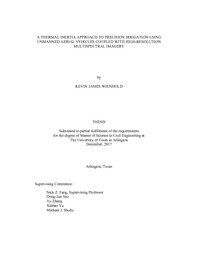
ATTENTION: The works hosted here are being migrated to a new repository that will consolidate resources, improve discoverability, and better show UTA's research impact on the global community. We will update authors as the migration progresses. Please see MavMatrix for more information.
Show simple item record
| dc.contributor.advisor | Fang, Nick Z. | |
| dc.creator | Wienhold, Kevin James | |
| dc.date.accessioned | 2018-02-15T20:21:48Z | |
| dc.date.available | 2018-02-15T20:21:48Z | |
| dc.date.created | 2017-12 | |
| dc.date.issued | 2018-02-15 | |
| dc.date.submitted | December 2017 | |
| dc.identifier.uri | http://hdl.handle.net/10106/27172 | |
| dc.description.abstract | Soil moisture is a critical variable in the optimization of irrigation scheduling in water resources management. Despite using tens to hundreds of thousands of gallons of water each day, many golf courses rely on a sparse network of point measurements to estimate irrigation requirements for turfgrass management. This study describes a novel system known as Precision Irrigation Soil Moisture Mapper (PrISMM) in which an unmanned aerial vehicle equipped with multispectral sensors is used to estimate volumetric water content (VWC) at a golf course using a thermal inertia approach. PrISMM consists of three central components, including (1) high-resolution thermal and optical remotely-sensed data, (2) site-specific soil analysis, and (3) surface energy balance modeling. The objective is to evaluate the feasibility of spatially-variable irrigation management for a golf course in north central Texas using PrISMM. Multispectral data are collected during the fall of 2017 in the visible, near infrared and longwave infrared (thermal) spectrum using a UAV capable of rapid and safe deployment for daily time-series estimates. Each data set consists of two flights collected on the same day, including a morning and midday flight. Diurnal temperature variations were then related to ground heat flux to derive thermal inertia. Using thermal and physical soil properties, thermal inertia estimates are converted to daily VWC estimates with a resolution of 8.6 cm. The accuracy of PrISMM is quantified using ground truthing with a time domain reflectometry soil moisture sensor. The model produces good estimates for VWC with an average coefficient of correlation of (r) = 0.89 and coefficient of determination of (R^2) = 0.79. Findings from this study indicate that PrISMM offers superior spatial and temporal resolution compared to in situ methods and may be implemented to precisely irrigate urban landscapes, thus saving millions of gallons of water annually. | |
| dc.format.mimetype | application/pdf | |
| dc.language.iso | en_US | |
| dc.subject | Unmanned aerial vehicles | |
| dc.subject | Thermal inertia | |
| dc.subject | Surface soil water content | |
| dc.subject | Multispectral remote sensing | |
| dc.subject | Precision irrigation | |
| dc.title | A Thermal Inertia Approach to Precision Irrigation using Unmanned Aerial Vehicles Coupled with High-Resolution Multispectral Imagery | |
| dc.type | Thesis | |
| dc.degree.department | Civil Engineering | |
| dc.degree.name | Master of Science in Civil Engineering | |
| dc.date.updated | 2018-02-15T20:21:49Z | |
| thesis.degree.department | Civil Engineering | |
| thesis.degree.grantor | The University of Texas at Arlington | |
| thesis.degree.level | Masters | |
| thesis.degree.name | Master of Science in Civil Engineering | |
| dc.type.material | text | |
| dc.creator.orcid | 0000-0002-3535-3960 | |
Files in this item
- Name:
- WIENHOLD-THESIS-2017.pdf
- Size:
- 15.33Mb
- Format:
- PDF
This item appears in the following Collection(s)
Show simple item record


